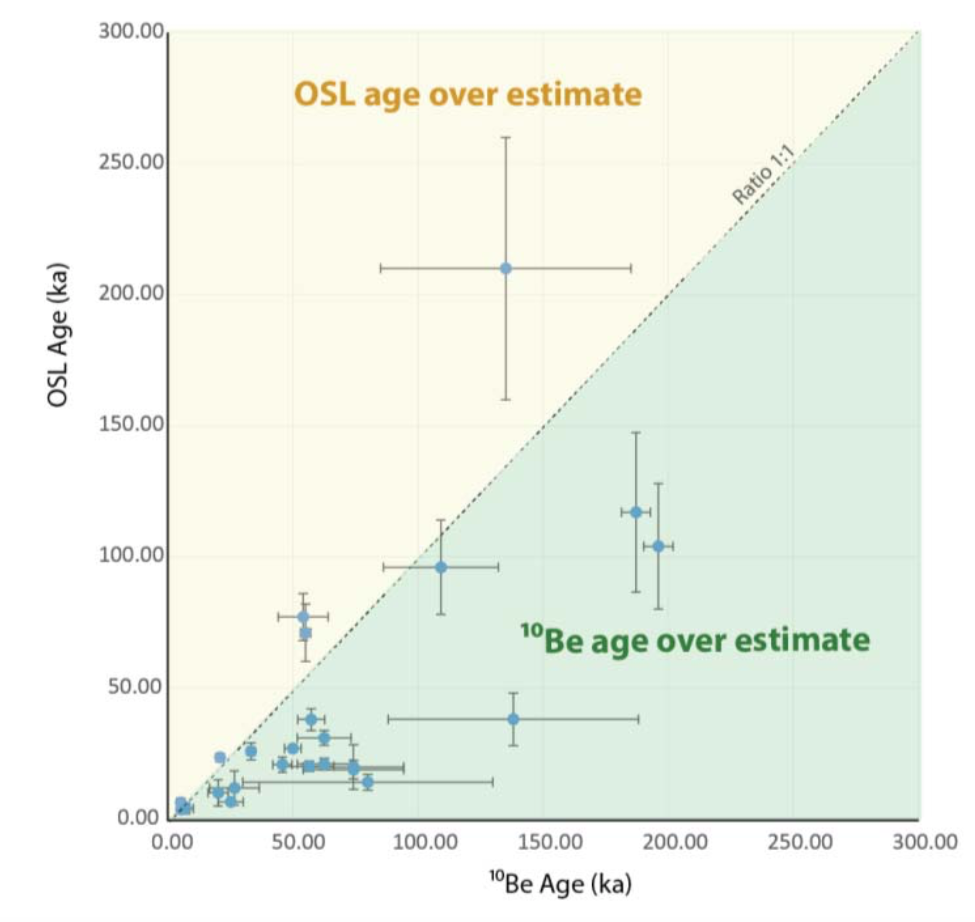Members
Breakthroughs in Quaternary Geochronology to fill in a key gap of knowledge in Active Tectonics
Overview
The determination of fault slip-rate relies on quantitative characterization of late-Quaternary (1-500 ka) deformation with accurate dating of geomorphological surfaces affected by the fault motion over multiple earthquake cycles. However, large epistemic uncertainties in dating alluvial surfaces with Optically Stimulated Luminescence (OSL) and Terrestrial Cosmogenic Nuclides (TCN) methods severely limit discussions and preclude our ability to understand behavior of active faults.

In this project, we are developing complementary approaches to accurately date late-Quaternary morphological surfaces through an exhaustive, detailed and unique direct comparison of both dating methods, a strategy that would then leads to major improvements in our understanding of the respective physical processes associated to these dating methods. “scientificOrganization.png” summarize the scientific organization of the project.
To better understand the systematics of these dating methods, we are combining both OSL and TCN dating methods on the same geomorphic markers with a high-resolution sampling. This approach has the potential to provide new important insights into the processes affecting alluvial landforms in different climatic setting. We aim to produce major advances in constraining sources for the natural variability of the OSL signal for a better understanding of luminescence characteristics from sediment populations with different light-exposure histories.
We are focusing on two challenging study cases where slip rates of active faults are still in debate due to epistemic uncertainties in dating alluvial surfaces. The results of this pioneering project are offering new perspectives for the large scientific community involved in active tectonics. At the national scale, there is no laboratory providing the possibility to apply both dating methods, and the French Earth Sciences community warrants an improvement and thorough understanding of OSL dating methods. Even at the international scale, only a few institutions host and master both OSL and TCN techniques and CEREGE is a unique opportunity in Quaternary geochronology.
Context
More than 60% of the world’s population live in areas where destructive earthquakes were recorded in the past. However, seismic hazard assessment remains highly problematic mainly related to the difficulties in accurately anticipating expected earthquakes magnitude and their recurrence times, these parameters being controlled primarily by the fault type and the slip rates. In active tectonics, geological slip rates are estimated using the ratio between the cumulative displacement of a geomorphic marker along the fault trace and its relative age. Accurate and precise age estimates are critical to reveal intriguing temporal patterns in fault slip over timescales ranging from 103–105 yr as it is done on some well-studied active faults (San Andreas Fault, North Anatolian Fault, Dead Sea Fault, Altyn Tagh Fault). Since the 80s, the quantification of slip rates has become more and more efficient. In one hand, thanks to the ever-improving resolution of satellites images (<1m), geologists identify with more accuracy the surface traces of active faults, displaced landforms and even past earthquake surface ruptures. Using the potential of remote sensing and digital elevation models, they produce detailed 3D reconstructions of fault morphology and geometric patterns.
In another hand, the applications of Quaternary dating methods have revolutionized the fields of tectonics and geomorphology. In Quaternary geochronology, the Terrestrial Cosmogenic Nuclides (TCN) and Optically Stimulated Luminescence (OSL) dating methods are geochronological tools available up to now to date deposits on timescales ranging from several tens of years to 500,000 years. Developed over the last few decades, they have been extensively applied to date and quantify various processes in an extremely wide range of environmental settings. Their exponentially increasing use is explained by the fact that they fill the temporal gap between the previously existing dating methods suitable for studying either short-term (i.e 1- 100 years) or long-term geological and environmental processes (i.e. 1 Ma – 1 Ga). Both methods are applied to date the emplacement of geomorphic markers but focus on different geomorphic processes. While the TCN method generally dates the exposure duration of the rock surface to cosmic rays [e.g. Gosse and Philipps, 2001], the OSL method provides burial duration of the sediment after deposition [e.g. Wallinga, 2002]. These two dating methods are now widely used in numerous studies to date the emplacement of alluvial fans, terraces and other morphological markers. However, despite the large number of scientific works devoted to the dating of geomorphic surfaces, many difficulties and debates remain. Large epistemic uncertainties in dating alluvial surfaces can severely limit discussions and preclude our ability to understand behavior of active faults in regard of the seismic cycle. “compOslTcn.png” summarize the current debate.
The image shown bellow presents such discrepancies found in recently published studies that combined both TCN and OSL dating to estimate the ages of alluvial surfaces in different climatic settings, with disparities up to 10- 100 ka between the two methods [Delong et Arnold., 2007; Nissen et al., 2009; Le Dortz et al., 2009, 2011; Owen et al., 2011; Viveen et al., 2012]. It is important to point out that OSL ages in most of these studies are often younger than TCN exposure ages. This is clearly evidenced when morphological surfaces are older than 50 ka. These critical observations question the reliability of the TCN and OSL dating techniques, although both are already used as routine methods. This is becoming even more critical considering that in many research papers, the authors, recognizing the difficulty to reconcile the ages derived from the two dating methods, often choose the deposition ages that seem the most reliable taking into account the local paleoclimatic reconstructions, but without independent age control to validate their assumptions.
A large source of uncertainty when applying TCN or OSL methods relates to the erosion-transport- deposition processes experienced by the sediment prior its final deposition. Owing to the nature of fluvial transport, it is well-known that pebbles and grains have followed during transport separate paths within the column water and thus have experienced different histories of exposure to sunlight/cosmic rays that will directly influence the latent OSL/TCN recorded signal.
In this project, we propose to empirically investigate physical and geomorphic processes influencing the acquisition, the restitution and the sensitivity of the TCN and OSL signals, through an exhaustive, detailed and direct comparison of both methods applied on typical alluvial deposits used for slip rate estimates at two key neotectonic sites. This proposed novel approach will necessarily refine the sampling strategies and therefore the determined ages used to constrain the spatial and temporal activity of active faults across the world. This project thus raises fundamental scientific questions with outcomes that will have direct and strong societal implications, in particular in our ability to better assess natural hazards.


